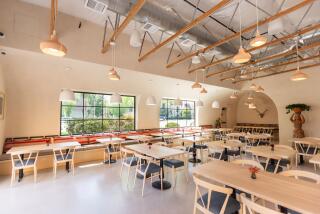The Fight Against Crime: Notes From The Front : He Gets All the Bugs Worked Out for Diners
Rodney Wortman can smell cockroaches.
After six years as an inspector for the Los Angeles County Health Department, his nose perks up when that distinctive, musky smell wafts through the back of a restaurant. He’s also got an eagle eye for uncovered food containers, dirty air vents and other unsanitary conditions that might ruin a diner’s appetite, or health.
“Every time you go out in the public and eat at an establishment, you’re at risk,” Wortman said. “Our job is to minimize that risk.”
Flashlight and can of insecticide dangling from his belt and thermometer and pen poking from his breast pocket, Wortman cruises through restaurants and stores across the eastern San Fernando Valley on regular quarterly inspections to make sure facilities meet all regulations. Occasionally Wortman and other inspectors have to close restaurants because of faulty equipment or, in the worst case, infestation.
Health inspectors have a full menu of duties. Other than restaurants, they also inspect markets, apartment complexes and businesses. Four times a year, owners of culinary establishments can expect a health inspector to show up on their doorstep and spend the next 30 minutes snooping about the facilities.
Inspectors are also obliged to give an establishment a once-over after a citizen complaint, although Wortman says he takes some of these beefs with a grain of salt, since they’re occasionally filed by laid-off employees.
Not every day is spent responding to calls of “There’s a fly in my soup.” On a recent day, Wortman drove up to inspect a small Mexican restaurant in a Sun Valley mini-mall because it had just changed ownership. After filling out sheaves of paperwork at one of the three tables inside, he was ready to go.
Wortman made a beeline to the pantry. He frowned. “The wood isn’t sanded or finished,” he said. He checked the insecticide the owner was using--not restaurant approved. Inexplicably, there was a container of antifreeze on one shelf.
The bathroom checked out. The area under the stove was clean. The soup and sauces were appropriately hot--above 140 degrees, a temperature at which most bacteria cannot live, he said.
And the refrigerator was a work of art. “This is very good,” Wortman said, approvingly eyeing the containers of food covered with tinfoil.
The antifreeze has to go, he told the owner, who nodded enthusiastically. Wortman made other suggestions--new insecticide, don’t store paint on the top shelves of the pantry (if it falls it will spill on the food).
Then he gave the owner a sticker showing how to properly wash food and signed the certificate, giving Tacos Karla’s a clean bill of health.
“Expect a visit from us four times a year,” he said.
“Too much,” quipped the owner.
A vast majority of restaurants are clean, especially those with kitchens open to view by the diners, Wortman said. “They tend to be a little more clean than the ones where you go through the mysterious swinging doors.”
But there’s always an exception. Wortman recalls a doughnut shop he once inspected, in which the door to a rear room was locked. He made the owner open it.
Inside was a dough mixer. He peered in.
At the bottom was a pool of water and a pair of tennis shoes. Turns out the owner had been doing her laundry in the dough mixer.
Wortman made her remove the device immediately.
More to Read
Sign up for Essential California
The most important California stories and recommendations in your inbox every morning.
You may occasionally receive promotional content from the Los Angeles Times.









